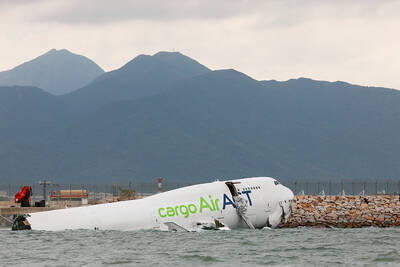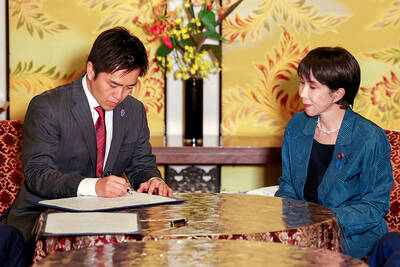South Korea yesterday said it would not send its F-35 jet fleet to Japan for heavy airframe maintenance, one of the two Asian hubs chosen by the US to service the Lockheed Martin Corp stealth fighter.
Instead, it is likely to fly the jets to Australia, about eight times further away than Japan and well beyond their operating range. The three nations — all key US allies — are the only regional players to have ordered the F-35s.
The F-35 program has been lauded as an example of the US and its allies working together to bolster interoperability, but in Asia, the maintenance plan is exacerbating a traditional rivalry between Seoul and Tokyo.
US Air Force Lieutenant General Christopher Bogdan, who runs the F-35 program for the US, told reporters on Wednesday that Japan would handle heavy maintenance for the jets in the northern Pacific staring in early 2018, with Australia to handle maintenance in the southern Pacific.
“There will never be a case where our fighter jets will be taken to Japan for maintenance,” said an official at South Korea’s arms procurement agency, the Defense Acquisition Program Administration.
“South Korea has the right to decide where to conduct maintenance for its F-35 jets, and it will decide whenever the need arises,” the official added.
The plan for now is for the 40 F-35s set to be acquired by South Korea to be serviced in Australia, an Australian Department of Defence source told reporters on condition of anonymity.
South Korea is to receive the first of its stealth planes in 2018.
A source familiar with the F-35 program said South Korea could — at a later stage — negotiate with Washington about the possibility of handling the heavy maintenance of its own F-35 jets.
Such a deal would require a significant investment by Seoul, including specialized equipment used to test the jets’ stealth.
However, barring unforeseen circumstances, the jets are not likely to require much heavy maintenance until five years after their delivery, said the source, who was not authorized to speak publicly.
Heavy maintenance involves repairs that get into the structure of the airplanes.
“At the moment, the regional hub in Japan will deal with the 42 Japanese F-35s. We will discuss with the Pentagon what others will be handled in Japan,” Japanese Ministry of Defense Aircraft Division Deputy Director Katsuyuki Komatsu said at a briefing in Tokyo.
He said that the discussion would cover the F-35s to be operated by South Korea and those to be flown by the US from bases in northeast Asia.
Bogdan said the F-35 program office would re-examine the maintenance assignments every two to three years, providing opportunities for other nations with F-35s to benefit from a market valued at billions of US dollars in coming years.
The US$399 billion weapons program has already produced 120 jets, with the US and foreign militaries gearing up to start operating the fighters around the world in coming years.
In Japan, the airframe maintenance decision benefits Mitsubishi Heavy Industries, which is already slated to run the final assembly and checkout plant being built in Japan at a cost of ¥63.9 billion (US$538.92 million).
Future engine work in Japan would be done by IHI Corp, which is already building engine components for Japan’s F-35s, a source familiar with the program said.
In Australia, the airframe maintenance work could be done by Britain’s BAE Systems, although the Australian government could opt to complete the work, the source said.
“The Australian defense industry stands to win well in excess of A$1.5 billion [US$1.22 billion] in related production and support work over the life of the program,” Australian Minister for Defence David Johnston said in a statement.

Indonesia was to sign an agreement to repatriate two British nationals, including a grandmother languishing on death row for drug-related crimes, an Indonesian government source said yesterday. “The practical arrangement will be signed today. The transfer will be done immediately after the technical side of the transfer is agreed,” the source said, identifying Lindsay Sandiford and 35-year-old Shahab Shahabadi as the people being transferred. Sandiford, a grandmother, was sentenced to death on the island of Bali in 2013 after she was convicted of trafficking drugs. Customs officers found cocaine worth an estimated US$2.14 million hidden in a false bottom in Sandiford’s suitcase when

CAUSE UNKNOWN: Weather and runway conditions were suitable for flight operations at the time of the accident, and no distress signal was sent, authorities said A cargo aircraft skidded off the runway into the sea at Hong Kong International Airport early yesterday, killing two ground crew in a patrol car, in one of the worst accidents in the airport’s 27-year history. The incident occurred at about 3:50am, when the plane is suspected to have lost control upon landing, veering off the runway and crashing through a fence, the Airport Authority Hong Kong said. The jet hit a security patrol car on the perimeter road outside the runway zone, which then fell into the water, it said in a statement. The four crew members on the plane, which

Japan’s ruling Liberal Democratic Party (LDP) and its junior partner yesterday signed a coalition deal, paving the way for Sanae Takaichi to become the nation’s first female prime minister. The 11th-hour agreement with the Japan Innovation Party (JIP) came just a day before the lower house was due to vote on Takaichi’s appointment as the fifth prime minister in as many years. If she wins, she will take office the same day. “I’m very much looking forward to working with you on efforts to make Japan’s economy stronger, and to reshape Japan as a country that can be responsible for future generations,”

SEVEN-MINUTE HEIST: The masked thieves stole nine pieces of 19th-century jewelry, including a crown, which they dropped and damaged as they made their escape The hunt was on yesterday for the band of thieves who stole eight priceless royal pieces of jewelry from the Louvre Museum in the heart of Paris in broad daylight. Officials said a team of 60 investigators was working on the theory that the raid was planned and executed by an organized crime group. The heist reignited a row over a lack of security in France’s museums, with French Minister of Justice yesterday admitting to security flaws in protecting the Louvre. “What is certain is that we have failed, since people were able to park a furniture hoist in the middle of